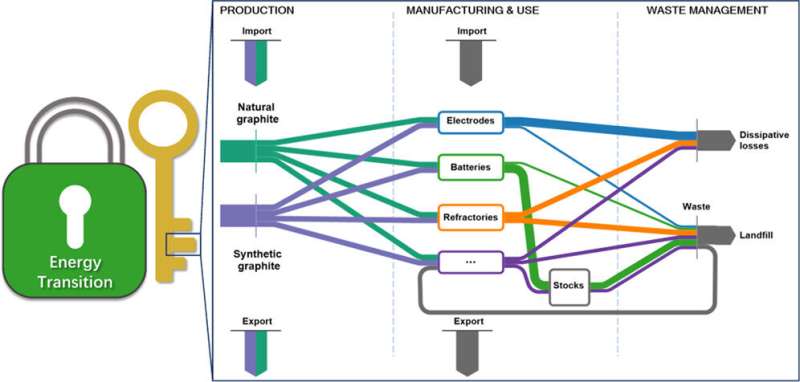Ramping up domestic graphite production could aid the green energy transition

Given the growing importance of graphite in energy storage technologies, a team of Northwestern researchers has conducted a study exploring ways to reduce reliance on imports of the in high-demand mineral, which powers everything from electric vehicles (EVs) to cell phones.
The paper, which published last week (Feb. 15) in the journal Environmental Science and Technology, is the first natural and synthetic graphite material flow analysis for the U.S., and considers 11 end-use applications for graphite, two waste management stages and three recycling pathways.
“If we want to produce more batteries domestically, we’re going to need to increase our production of graphite,” said Northwestern University chemical engineer Jennifer Dunn. “But the question is, how can we do so in a way that contributes to decarbonization goals?”
Dunn is an associate professor of chemical and biological engineering at Northwestern’s McCormick School of Engineering and director of the Center for Engineering Sustainability and Resilience. The paper was co-authored by Jinrui Zhang, who at the time of the study initiation was a post-doctoral scholar in chemical and biological engineering; and Chao Liang, previously a member of Northwestern’s Institute for Sustainability and Energy (ISEN). Both co-authors are alumni of Dunn’s research group.
The U.S. uses mostly synthetic graphite, which is produced from by-products of the fossil fuel industry and creates a paradoxical relationship between graphite and technologies like electric vehicles (EVs) that aim to remove fossil fuel supply chains from transportation and cut greenhouse gas emissions.
Natural graphite, alternately, is sourced from mines and imported to the U.S. mostly from China. Nearly all the graphite used in the U.S. goes into electrodes for steel manufacturing. As the battery supply chain in the U.S. ramps up, measures like the Inflation Reduction Act seek to incentivize the use of domestically sourced materials—including graphite—in U.S.-made batteries.
Given the growing importance of graphite in energy storage technologies like lithium-ion batteries, the team carried out this analysis to characterize the major production routes of the mineral, its main uses and opportunities to reduce consumption through recycling. Data from 2018—the most recent period with sufficient data for this type of analysis—was used for the study.
Most of the graphite consumed in the U.S. in 2018 was synthetic graphite, with 63% of this graphite produced domestically. Production of synthetic graphite emits more greenhouse gases than mining natural graphite (natural graphite has between 62% and 89% lower greenhouse gas emissions). Synthetic graphite is also more expensive. However, the U.S. does not mine natural graphite but imports it, predominately from China.
As the only material that conducts electricity besides metal, the main use of graphite is for electrodes in steel making. As demand for low-carbon steel increases, more graphite may be consumed in electrode production. During steel making, graphite burns and dissipates—much like how graphite pencils start to disappear as you write with them. Though it is not impossible to recover dissipated graphite, it rarely is, diminishing opportunities to recover the mineral through recycling. Technologies to recover graphite from lithium-ion batteries are increasing in maturity but not yet common.
Dunn said that part of the focus on domestic sources and recycling of graphite-containing products like lithium-ion batteries is based on the current supply chain’s potential instability and projected increasing demand.
“You can recover some graphite from recycling lithium-ion batteries, but batteries last a while, so it may be a decade before you can get graphite back from EVs that reach the end of their life,” Dunn said. “However, we are also building the bioeconomy in the U.S., and that can include making graphite from biomass. This opens up another supply option beyond making graphite from fossil fuel industry by-products or mining.”
With the passage of the Inflation Reduction Act of 2022, more funding will move toward the use of domestically sourced and recycled graphite, and Dunn said the U.S. needs to be ready to make the shift.
More information:
Jinrui Zhang et al, Graphite Flows in the U.S.: Insights into a Key Ingredient of Energy Transition, Environmental Science & Technology (2023). DOI: 10.1021/acs.est.2c08655
Citation:
Ramping up domestic graphite production could aid the green energy transition (2023, February 22)
retrieved 22 February 2023
from https://techxplore.com/news/2023-02-ramping-domestic-graphite-production-aid.html
This document is subject to copyright. Apart from any fair dealing for the purpose of private study or research, no
part may be reproduced without the written permission. The content is provided for information purposes only.
For all the latest Technology News Click Here
For the latest news and updates, follow us on Google News.

